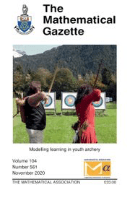
MATHEMATICAL GAZETTE
Scope & Guideline
Cultivating Curiosity in the World of Mathematics
Introduction
Aims and Scopes
- Exploration of Mathematical Concepts:
The journal features articles that delve into various mathematical theories and concepts, ranging from elementary to advanced topics, encouraging a deeper understanding of the subject. - Interdisciplinary Connections:
It showcases the interplay between mathematics and other disciplines, demonstrating how mathematical principles can be applied in fields such as physics, computer science, and economics. - Educational Strategies and Pedagogy:
A significant focus is on teaching methodologies, offering insights and innovative approaches to enhance mathematics education and engagement in classrooms. - Problem Solving and Puzzles:
The journal often includes problem corners and puzzles, fostering critical thinking and problem-solving skills among its readers. - Historical Perspectives:
Articles also explore the historical development of mathematical ideas and figures, providing context and appreciation for the evolution of the discipline. - Visual and Intuitive Explanations:
The use of visual aids and intuitive explanations is encouraged to make complex mathematical ideas more understandable and relatable.
Trending and Emerging
- Mathematical Applications in Real Life:
There is a growing trend towards exploring how mathematical concepts apply to real-world scenarios, including finance, environmental science, and technology, making mathematics more relevant and engaging. - Integration of Technology in Mathematics Education:
Papers discussing the use of technology, including software and online resources, to enhance mathematics teaching and learning are increasingly popular. - Collaborative Learning and Group Problem Solving:
The journal is seeing more content focused on collaborative learning strategies and group problem-solving activities, reflecting modern educational practices that emphasize teamwork. - Mathematics and Art:
Emerging themes include the intersection of mathematics and art, exploring how mathematical principles can inspire artistic expression and visual representation. - Cognitive and Psychological Aspects of Learning Mathematics:
There is a rising interest in understanding the cognitive processes involved in learning mathematics, which informs teaching strategies and curriculum development.
Declining or Waning
- Purely Theoretical Mathematics:
There has been a noticeable decrease in papers focused solely on abstract or theoretical mathematics, suggesting a shift towards more applied or pedagogical content. - Advanced Topics in Abstract Algebra:
Discussions centered around complex topics in abstract algebra seem to be less frequent, possibly due to a broader focus on more accessible content for a general audience. - Traditional Geometry:
While geometry remains a core topic, traditional Euclidean geometry discussions are waning, with more emphasis placed on applied geometric concepts and their interdisciplinary applications. - Heavy Mathematical Proofs:
There is a decline in articles featuring lengthy, intricate mathematical proofs, as the journal increasingly values clarity and accessibility over complexity. - Historical Mathematical Figures:
While historical context remains important, specific studies on lesser-known historical figures in mathematics are becoming less common, indicating a potential shift towards more contemporary relevance.
Similar Journals
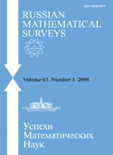
RUSSIAN MATHEMATICAL SURVEYS
Exploring the depths of mathematical theory and application.RUSSIAN MATHEMATICAL SURVEYS is a leading scholarly journal published by the Steklov Mathematical Institute of the Russian Academy of Sciences, dedicated to advancing the field of mathematics since its inception in 1970. With an ISSN of 0036-0279 and E-ISSN of 1468-4829, this journal publishes comprehensive surveys and research papers that span a variety of mathematical disciplines, offering insights into new theories and methodologies. Ranked in Q2 of the mathematics category and positioned at the 62nd percentile among general mathematics journals in Scopus, it serves as an essential resource for mathematicians, researchers, and students alike. While it currently does not offer open access options, its significant impact on the mathematical community is reflected in its rigorous publication standards and wide readership. The journal plays a crucial role in disseminating cutting-edge research and promoting mathematical discourse within the global academic community, making it a must-read for anyone invested in the dynamics of modern mathematics.

Bulletin of the Institute of Mathematics Academia Sinica New Series
Cultivating Insights for a New Era of Mathematical Discovery.The Bulletin of the Institute of Mathematics Academia Sinica New Series is a prestigious international journal dedicated to the dissemination of high-quality research in the field of mathematics. Published by ACAD SINICA, this scholarly journal serves as a vital platform for researchers, professionals, and students alike to explore innovative mathematical theories, methodologies, and applications. With an ISSN of 2304-7909 and an E-ISSN of 2304-7895, the journal is committed to maintaining rigorous academic standards while fostering an environment of open discourse and collaboration within the mathematical community. Though specific impact metrics are still being developed, the journal is poised to contribute significantly to the advancement of mathematical knowledge, encouraging groundbreaking studies and interdisciplinary approaches. Researchers are invited to share their insights and benefit from this important resource, which supports the global advancement of mathematics from its base in Beijing, People's Republic of China.

Vietnam Journal of Mathematics
Bridging Theory and Application in MathematicsVietnam Journal of Mathematics, published by SPRINGER SINGAPORE PTE LTD, serves as a prominent platform for disseminating high-quality research in the field of mathematics. With an ISSN of 2305-221X and E-ISSN 2305-2228, this esteemed journal has established itself as a noteworthy contributor to the academic landscape since its inception in 2013, continuing its coverage until 2024. Enjoying a Q2 ranking in Mathematics (miscellaneous) for 2023, and holding a commendable Scopus rank of #126 out of 399 in General Mathematics, the journal stands at the intersection of innovation and scholarly excellence. Although still developing its open-access model, it provides a valuable resource for researchers, professionals, and students alike, who are keen to explore the vast universe of mathematical inquiry and application. As the journal progresses, it strives not only to publish original research but also to foster dialogue and collaboration within the global mathematics community.
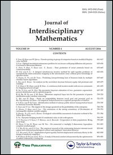
JOURNAL OF INTERDISCIPLINARY MATHEMATICS
Inspiring the Next Generation of Mathematicians with Cutting-Edge ResearchJOURNAL OF INTERDISCIPLINARY MATHEMATICS, published by TARU PUBLICATIONS, is a renowned publication that serves as a critical platform for scholars and practitioners in the field of mathematics, particularly focusing on Analysis and Applied Mathematics. Since its inception in 1998, the journal has provided a robust forum for interdisciplinary research, fostering collaboration across various mathematical domains and enhancing the understanding of complex mathematical concepts. With a commendable Scopus ranking reflecting its quality and impact—Rank #55/193 in Mathematics Analysis and Rank #258/635 in Applied Mathematics—this journal is classified within the Q2 quartile, illustrating its significant contribution to the academic community. Although it follows a traditional subscription model, it encourages accessible scholarship for researchers based in India and beyond. By publishing cutting-edge research, the JOURNAL OF INTERDISCIPLINARY MATHEMATICS seeks to inspire and equip the next generation of mathematicians, making it an invaluable resource for anyone deeply invested in the advancement of mathematical sciences.

Japanese Journal of Mathematics
Discovering the Depths of Mathematical InnovationThe Japanese Journal of Mathematics, published by SPRINGER, stands as a premier platform for the dissemination of high-quality research in the field of mathematics. With its ISSN 0289-2316 and E-ISSN 1861-3624, this prestigious journal has been continually contributing to the academic community since its inception. Spanning a broad range of mathematical disciplines, the journal enjoys a strong reputation, recognized in the 2023 category quartiles as Q1 in Mathematics (miscellaneous), placing it among the top-tier journals in the field. Its Scopus rank of #41 out of 399, which reflects an impressive 89th percentile, further underscores its influence and the quality of articles it publishes. The Japanese Journal of Mathematics is dedicated to fostering scholarly exchange and advancing mathematical research, making it an indispensable resource for researchers, professionals, and students alike. Although it does not offer open access, its comprehensive archives provide a wealth of knowledge for those seeking to deepen their understanding of mathematical theories and applications.

Honam Mathematical Journal
Advancing mathematical frontiers through rigorous research.The Honam Mathematical Journal, published by the prestigious Honam Mathematical Society, is a distinguished platform dedicated to advancing research and dissemination in the field of mathematics. With its ISSN 1225-293X and E-ISSN 2288-6176, this journal serves as a conduit for innovative mathematical studies, covering a broad spectrum of topics encompassing both theoretical and applied mathematics. Based in Gwangju, South Korea, at the Department of Mathematics, Chosun University, it aims to foster global collaboration and knowledge exchange among researchers, professionals, and students alike. Although the journal does not currently offer open access, it maintains a commitment to high scholarly standards, which is reflected in its comprehensive peer-review process. The Honam Mathematical Journal stands as a vital resource in the mathematical community, contributing significantly to the development and application of mathematical thought in various scientific disciplines.
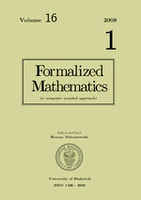
Formalized Mathematics
Fostering Collaboration in Formalized Mathematical ResearchFormalized Mathematics is a pioneering open-access journal published by SCIENDO, dedicated to the field of formalized systems and mathematical foundations. Since its inception in 2006, it has provided a platform for researchers to discuss and disseminate advancements in applied mathematics and computational mathematics, emphasizing formalization in mathematical reasoning. Although recent coverage in Scopus has been discontinued, the journal still serves as a valuable resource for academics looking to deepen their understanding of formalized approaches to mathematical problems. With its ISSN 1898-9934, the journal not only promotes unrestricted access to quality research but also facilitates collaboration among mathematicians and computer scientists. Given its rankings—20th percentile in Applied Mathematics and 18th percentile in Computational Mathematics—Formalized Mathematics is a vital conduit for innovative research, making it a significant asset for students, professionals, and scholars aiming to explore the intersection of mathematics and formal logic.

CSIAM Transactions on Applied Mathematics
Bridging Theory and Practice in MathematicsCSIAM Transactions on Applied Mathematics is a prestigious academic journal published by GLOBAL SCIENCE PRESS, specializing in the rapidly evolving field of applied mathematics. Established in 2020 and operating in Hong Kong, this journal has quickly gained recognition for its rigorous peer-reviewed articles and contributions that integrate theoretical frameworks with practical applications. With an impressive ranking of #261 out of 635 in the Scopus database, and a 2023 quartile ranking of Q2 in Applied Mathematics, it is positioned to be a vital resource for researchers, professionals, and students alike. The journal offers a platform for innovative research that is essential for addressing contemporary challenges in science and engineering, promoting interdisciplinary collaboration and knowledge exchange. Although currently not Open Access, it provides invaluable insights through its curated content, truly reinforcing its role as a cornerstone in the field of applied mathematics.

Publications de l Institut Mathematique-Beograd
Nurturing a diverse landscape of mathematical exploration.Publications de l Institut Mathematique-Beograd is a distinguished journal in the field of mathematics, published by Publications L Institut Mathematique Matematicki in Serbia. With an ISSN of 0350-1302, it aims to disseminate high-quality research across various domains of mathematics, fostering academic discourse and innovation. Despite its open access status being unspecified, the journal is accessible to a wide audience, supporting an inclusive environment for knowledge sharing. The journal's impact is reflected in its 2023 category quartile ranking of Q3 in Mathematics (Miscellaneous), verifying its contribution to the mathematical community. With a Scopus ranking placing it in the 22nd percentile of general mathematics, it serves as a vital resource for researchers, professionals, and students eager to stay abreast of contemporary mathematical advancements. Since its convergence in 2002, and with ongoing publications continuing through 2024, this journal remains a crucial platform for sharing innovative mathematical ideas and results.
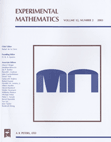
EXPERIMENTAL MATHEMATICS
Unlocking the Potential of Mathematics through ExperimentationEXPERIMENTAL MATHEMATICS is a distinguished journal published by Taylor & Francis Inc, dedicated to the burgeoning field of mathematics with a special focus on experimental methodologies that illuminate mathematical theories and applications. With an ISSN of 1058-6458 and an E-ISSN of 1944-950X, this journal has been pivotal in advancing research from 1992 to 2024, achieving an impressive Q2 ranking in the Mathematics category for 2023. It serves as a vital platform for researchers and practitioners to share innovative experimental results that contribute to mathematical understanding and training. Although it operates on a subscription basis, the journal is accessible to a broad audience within the mathematical community, boasting a Scopus rank of #153 out of 399 in General Mathematics, placing it in the 61st percentile. Research published in EXPERIMENTAL MATHEMATICS not only enhances academic discourse but also fosters collaboration between theoretical and applied mathematicians, making it an essential resource for students, professionals, and researchers alike.